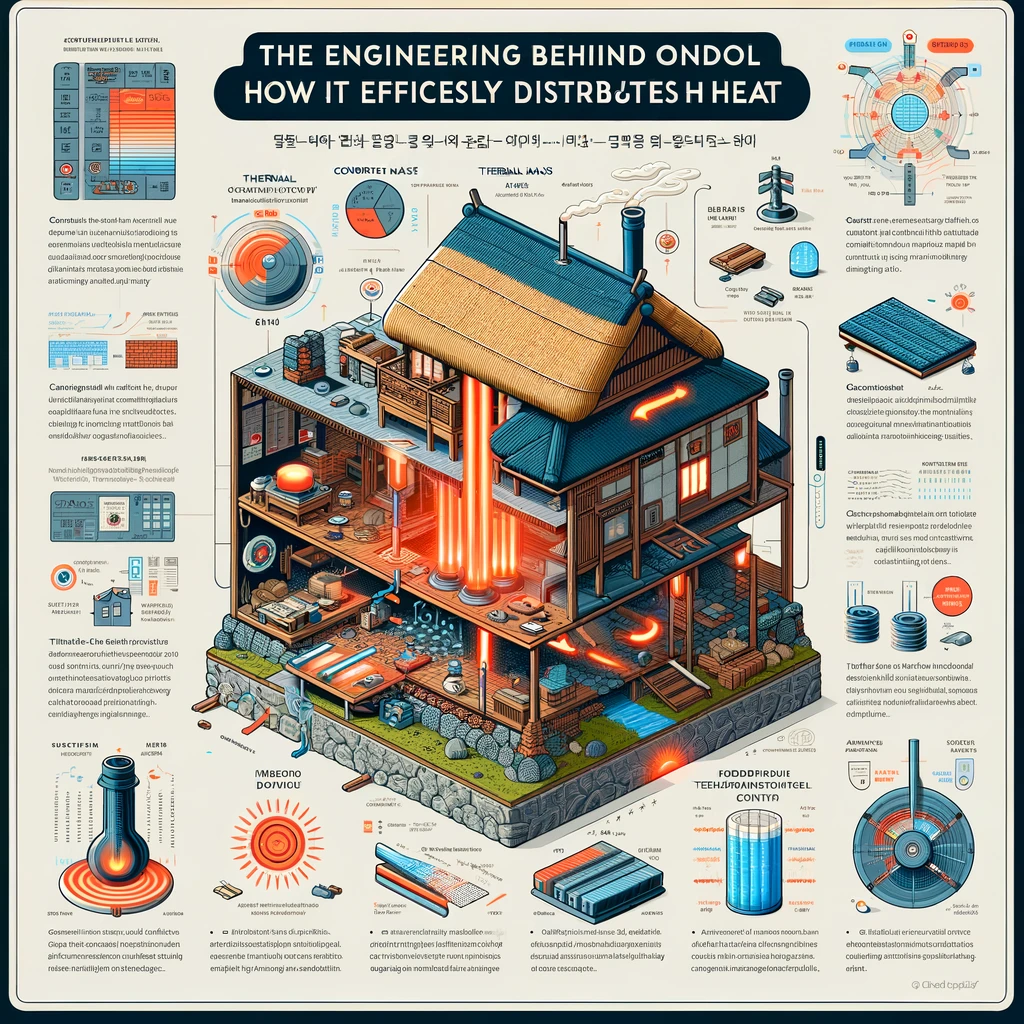목차
The Engineering Behind Ondol – How It Efficiently Distributes Heat
Introduction
Ondol, the traditional Korean floor heating system, embodies a blend of simplicity and efficiency in thermal engineering. This ancient system not only exemplifies early human ingenuity in living environment control but also aligns with modern principles of sustainable design and energy efficiency. This comprehensive exploration delves into the engineering concepts behind ondol, explaining how this traditional method has mastered the efficient distribution of heat, its evolution over the centuries, and its relevance in contemporary architecture.

Historical Overview of Ondol
The concept of ondol dates back to the Proto-Three Kingdoms period in Korea, around the first century BCE. Initially used by nobility, the technique spread and became a standard feature in Korean homes. Traditional ondol consists of an underfloor heating system where heat from a wood-fired stove passes through stone channels under the floors of living spaces. The evolution from rudimentary smoke tunnels to sophisticated heating systems over the centuries marks significant advances in material use and construction techniques.
Fundamental Design and Operation
Components of Traditional Ondol:
Agni (Fireplace): This is where the fire is lit, typically located on one side of the building.
Gudeuljang (Flue Channels): These are the pathways beneath the floor through which the heat travels.
Maru (Floor): Made of stone or concrete, this floor absorbs heat from the flue channels and radiates it upward.
Heat Generation and Transfer:
The process begins in the agni, where wood or other biofuels are combusted, generating heat.
The heat and smoke move through the gudeuljang, transferring heat to the stone or concrete floor above.
The floor absorbs the heat and gradually radiates it into the room, providing consistent and long-lasting warmth.
Engineering Principles in Ondol
Thermal Mass:
Ondol floors are built with materials that have high thermal mass, such as stone or concrete, which store and slowly release heat. This property allows the floor to remain warm long after the fire has extinguished, ensuring efficient use of energy.
Conductive Heat Transfer:
The system utilizes conductive heat transfer to move heat from the high-temperature source (fire) to the cooler parts of the floor. The direct contact between the hot smoke and the underside of the floor enhances this process, making it more efficient than forced-air systems.
Radiant Heating:
Unlike convection heating, which warms the air, radiant heating directly warms objects and people in the room. This method reduces energy loss and eliminates the discomfort of blowing hot air, leading to a more comfortable living environment.
Natural Convection Currents:
As the air above the heated floor warms, it rises, and cooler air takes its place, setting up a natural convection current within the room. This circulation helps distribute the heat evenly, optimizing the comfort level throughout the space.
Modern Adaptations and Technological Enhancements
With advances in technology, modern ondol systems have adapted to include more sustainable and efficient energy sources, such as gas, electricity, and even solar power. These systems often use water pipes instead of smoke channels, where hot water circulates beneath the floor, applying the same principles of heat transfer but with modern control systems like thermostats to regulate temperature precisely.
Impact on Sustainable Architecture
The principles of ondol align well with modern sustainable architecture goals. The efficient use of materials and energy in ondol provides a model for eco-friendly heating solutions in contemporary building designs. Moreover, the emphasis on using local materials and reducing energy consumption through effective heat distribution supports broader environmental sustainability efforts.
Conclusion
The engineering behind the traditional Korean ondol system showcases a remarkable example of early thermal management that remains relevant in modern times. By understanding the principles that make ondol an efficient heat distributor, architects and engineers can integrate these ideas into innovative designs that prioritize energy efficiency and environmental sustainability. Ondol’s enduring legacy continues to influence heating technologies and inspire solutions that address the challenges of today’s built environment.
Go Blog Home
